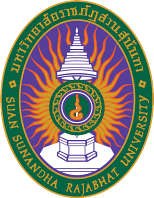The Novelty of Product Novelty Combined with Local Wisdom on Consumer Attitudes and Purchase Intentions: Sa Chaeng Sub district, Bang Rachan District, Singburi Province
Keywords:
The Influence of Novelty, Local Wisdom, Attitude, Purchase IntentionsAbstract
This research was aimed to study 1) develop and examine a causal relationship model between novelty, attitude and purchase intention of products mixed with local wisdom.
2) Investigate the relationship between novelty, attitude, and purchase intention of products infused with local wisdom, including direct and indirect effects as well as the overall influence. The researcher collects data from consumers of products mixed with local wisdom using a survey and descriptive research method. The original sample of 400 people. Analyzed by structural equation modeling. The research findings are summarized below;
The path analysis hypothesis testing results, both direct effect, indirect effect, and total effect, revealed that novelty variables had a direct influence on attitudes. It was found that the consumer's level of novelty had a direct positive influence on the consumer's attitude toward local wisdom products. The hypothesis was accepted at the statistical significance level of 0.05, with a p-value of 0.001 and a factor weight of 0.812. This can explains why, the higher a product's level of novelty, the higher the level of consumer attitude. The level of novelty among consumers had a direct positive influence on their purchasing intentions for local wisdom-added products. According to the test results, the hypothesis that was rejected at the statistical significance level of 0.05 had a p-value of 0.946 and a factor weight of -0.008, which was inconsistent with the reviewed literature. And the level of positive attitude of consumers had a direct positive influence on the level of purchase intention of consumers toward products mixed with local wisdom. The hypothesis was rejected at the statistical significance level of 0.05 with a p-value of 0.001, indicating that the higher the level of consumer attitudes toward a product, the higher the demand for it. As a result, the community's marketing strategy should focus on increasing the level of liking and positive attitude toward cracker products in the community.
References
งามพิศ สัตย์สงวน. (2558). มานุษยวิทยากายภาพ: วิวัฒนาการทางกายภาพและวัฒนธรรม. กรุงเทพฯ: จุฬาลงกรณ์มหาวิทยาลัย.
ณัฐธยาน์ ภัทรพิเศษวงศ์. (2556). โมเดลสมการโครงสร้างของผลการดำเนินงานระบบโลจิสติกส์และ การบริหารลูกค้าสัมพันธ์ในธุรกิจพาณิชย์อิเล็กทรอนิกส์ (วิทยานิพนธ์ปริญญาบริหารธุรกิจมหาบัณฑิต). มหาวิทยาลัยเกษตรศาสตร์.
Abdullah, Q. A. & Yu, J. (2019). Attitudes and Purchase Intention towards Counterfeiting Luxurious Fashion Products among Yemeni Students in China. American Journal of Economics, 9(2), 53-64.
Bollen, K. A. (1989). Structural equations with latent variables. New York: John Wiley & Sons.
Cronbach, L. J. (1970). Essentials of Psychological Test. (5th ed.). New York: Harper Collins.
Fornell, C., & Larcker, D. F. (1981). Evaluating structural equation models with unobservable variables and measurement error. Journal of Marketing Research, 18(1), 39–50.
Hair, J. F., Black, W. C., Babin, B. J. and Anderson, R. E. (2010) Multivariate Data Analysis. (7th Ed.). New York: Pearson.
Howard, D. J., & Gengler, C. (2001). Emotional contagion effects on product attitudes. Journal of Consumer Research, 28(2), 189–201.
Kuo-Kuang Fan and Ying Zhou, (2020). The Influence of Traditional Cultural Resources (TCRs) on the Communication of Clothing Brands. Sustainability, 12(6), 2379.
Mostaque Ahmed Zeba and Anushe Zebal. (2020). Success Factors of Local Retail Apparel Clothing Brands in a Southeast Asian Market. International Journal of Marketing Studies, 12(3), 52-64.
Qin, Z., Song, Y., Tian, Y. 2019. The Impact of Product Design with Traditional Cultural Properties (TCPs) on Consumer Behavior Through Cultural Perceptions: Evidence from the Young Chinese Generation. Sustainability, 11(426), 1-17.
Unger, L. S. & Kernan, J. B. 1983. On the Meaning of Leisure: An Investigation of Some Determinants of the Subjective Experience. Journal of Consumer Research, 9(4), 381-392.
Downloads
Published
How to Cite
Issue
Section
License
Copyright (c) 2023 The Journal of Development Administration Research

This work is licensed under a Creative Commons Attribution-NonCommercial-NoDerivatives 4.0 International License.
บทความที่ได้รับการตีพิมพ์เป็นลิขสิทธิ์ของมหาวิทยาลัยราชภัฏสวนสุนันทา
ข้อความที่ปรากฏในบทความแต่ละเรื่องในวารสารวิชาการเล่มนี้เป็นความคิดเห็นส่วนตัวของผู้เขียนแต่ละท่านไม่เกี่ยวข้องกับมหาวิทยาลัยราชภัฏสวนสุนันทา และคณาจารย์ท่านอื่นๆ ในมหาวิทยาลัยฯ แต่อย่างใด ความรับผิดชอบองค์ประกอบทั้งหมดของบทความแต่ละเรื่องเป็นของผู้เขียนแต่ละท่าน หากมีความผิดพลาดใดๆ ผู้เขียนแต่ละท่านจะรับผิดชอบบทความของตนเองแต่ผู้เดียว



